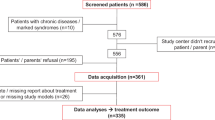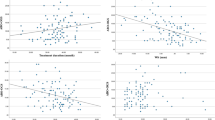Abstract
The aim of this study was the retrospective evaluation of the outcome of orthodontic treatment in consecutively treated adult patients.
Of 147 adult patients, it was possible to evaluate the records of 88 patients (57 female, 31 male) before (T1) and after treatment (T2), and of 20 of these patients 3.3 years on average after completion of the retention phase (T3). During treatment planning, a nearly “ideal” result was considered attainable (ideal group) for 46 patients, and a “compromise” result (compromise group) was seen as realistic for 42. The assessment was made using the PAR (Peer Assessment Rating) index and the Aesthetic Component (AC) and Dental Health Components (DHC) of the IOTN (Index of Orthodontic Treatment Need). Average length of treatment in the ideal group was 2.4 years, i. e. nearly twice as long as in the compromise group.
The PAR score was reduced by an average of 56% (T2); the reduction in the ideal group was 73%, and in the compromise group 37%. Among the 20 patients for whom at least 6 months had elapsed since completion of the retention phase, a statistically significant relapse between T2 and T3 was observed. The evaluation of overjet and overbite and, in the ideal group, of the midline and maxillary front teeth were primarily responsible for the worsening of the PAR scores between T2 and T3. According to the AC, 53 patients (60%) had moderate to definite treatment needs at the beginning of treatment. Following completion of active treatment, 69 patients (78%) no longer demonstrated treatment indications for aesthetic or psychosocial reasons. Based on the DHC, 88% of the patients were in definite or moderate need of treatment (T1); in contrast, treatment was no longer indicated in 84% at T2. In general, a marked improvement of the examined morphological parameters was observed.
Zusammenfassung
Ziel der Arbeit war die retrospektive Bewertung des kieferorthopädischen Therapieerfolgs bei fortlaufend behandelten erwachsenen Patienten.
Von 147 erwachsenen Patienten konnten die Unterlagen von 88 Patienten (57 weibliche, 31 männliche) vor (T1) und nach der Behandlung (T2) sowie bei 20 Patienten im Durchschnitt 3,3 Jahre nach Abschluß der Retention (T3) ausgewertet werden. Bei 46 Patienten wurde bereits bei der Behandlungsplanung ein annähernd “ideales” Ergebnis als Ziel angestrebt (Idealgruppe) und bei 42 ein “Kompromiß”-Ergebnis (Kompromißgruppe). Die Beurteilung erfolgte mit Hilfe des PAR-Indexes (Peer Assessment Rating) und der Aesthetic Component (AC) und der Dental Health Components (DHC) des IOTN (Index of Orthodontic Treatment Need). Die durchschnittliche Behandlungsdauer in der Idealgruppe war mit 2,4 Jahren nahezu doppelt so lang wie die in der Kompromißgruppe.
Der PAR-Wert konnte im Durchschnitt um 56% reduziet werden (T2); für die Idealgruppe betrug die Reduktion 73% und für die Kompromißgruppe 37%. Bei den 20 Patienten, die mindestens sechs Monate außerhalb der Retention waren, konnte ein statistisch signifikantes Rezidiv zwischen T2 und T3 beobachtet werden. Für die Verschlechterung der PAR-Werte zwischen T2 und T3 waren vor allem die Bewertung von Overjet und Overbite sowie in der Idealgruppe die Bewertung der Mittellinie und der Oberkieferfront verantwortlich. Zu Beginn der Behandlung bestand gemäß des AC bei 53 Patienten (60%) moderater bzw. eindeutiger Behandlungsbedarf. Nach Abschluß der aktiven Behandlung wiesen 69 Patienten (78%) keine Behandlungsindikation aus ästhetischen bzw. psychosozialen Gründen mehr auf. Anhand der DHC bestand bei 88% der Patienten eindeutiger oder moderater Behandlungsbedarf (T1), hingegen zum Zeitpunkt T2 bei 84% keine Behandlungsindikation mehr. Generell konnte eine markante Besserung der untersuchten morphologischen Parameter festgestellt werden.
Similar content being viewed by others
References
Berg R, Fredlund A. Evaluation of orthodontic treatment results. Eur J Orthod 1981;3:181–5.
Berg R. Motivation als ausschlaggebender Faktor bei Erwachsenenbehandlung. Fortschr Kieferorthop 1986;47:287–94.
Berg R. Evaluation of orthodontic results — a discussion of some methodological aspects. Angle Orthod 1991;4:261–6.
Birkeland K, Boe OE, Wisth PJ. Orthodontic concern among 11-year-old children and their parents compared with orthodontic treatment need assessed by Index of Orthodontic Treatment Need. Am J Orthod Dentofac Orthop 1996;110:197–205.
Birkeland K, Boe OE, Wisth PJ. Subjektive Bewertung von dentalen und psychosozialen Ergebnissen nach kieferorthopädischer Behandlung. J orofac Orthop/Fortschr Kieferorthop 1997;58:44–61.
Birkeland K, Furevik J, Boe OE, et al. Evaluation of treatment and post-treatment changes by the PAR Index. Eur J Orthod 1997;19:279–88.
Björk A, Krebs A, Solow B. A method for epidemiological registration of malocclusion. Acta Odontol Scand 1964;22:27–40.
Brook PH. The development of an orthodontic treatment priority index. University of Manchester: M. Sc. Thesis, 1987.
Brook PH, Shaw WC. The development of an index of orthodontic treatment priority. Eur J Orthod 1989;11:309–20.
Buchanan IB, Downing A, Stirrups DR. A comparison of the Index of Orthodontic Treatment Need applied clinically and to diagnostic records. Br J Orthod 1994;21:185–8.
Buchanan IB, Russell JI, Clark JD. Practical application of the PAR Index: An illustrative comparison of the outcome of treatment using 2 fixed appliance techniques. Br J Orthod 1996;23:351–7.
Burden DJ, Holmes A. The need for orthodontic treatment in the child population of the United Kingdom. Eur J Orthod 1994;16:395–9.
DeGuzman L, Bahiraei D, Vig KWL, et al. The validity of the Peer Assessment Rating Index for malocclusion severity and treatment difficulty. Am J Orthod Dentofac Orthop 1995;107:172–6.
Draker HL. Handicapping labio-lingual deviations. A proposed index for public health purposes. Am J Orthodont 1960;46:295–305.
Eismann D. Reliable assessment of morphological changes results of orthodontic treatment. Eur J Orthod 1980;2:19–25.
Espeland LV, Ivarsson K, Stenvik A. A new Norwegian index of orthodontic treatment need related to orthodontic concern among 11-year-olds and their parents. Commun Dent Oral Epidem 1992;20:274–9.
Evans MR, Shaw WC. Preliminary evaluation of an illustrated scale for rating dental attractiveness. Eur J Orthod 1987;9:314–8.
Fellner U, Schlömer R. Der PAR-Index — eine praktikable Methode der Qualitätsicherung. J Orofac Orthop/Fortschr Kieferorthop 1996;10:193–0.
Fox NA, Richmond S, Wright JL, et al. Factors affecting the outcome of orthodontic treatment within the General Dental Service. Br J Orthod 1997;24:217–21.
Gottlieb EL. Grading your orthodontic treatment results. J Clin Orthod 1975;9:156–61.
Grainger RM. The treatment priority index. Washington: National Center for Health Statistics Series II No. 25, 1967.
Holmes A. The subjective need and demand for orthodontic treatment. Br J Orthod 1992;19:287–97.
Holmes A, Willmot DR. The Consultant Orthodontists Group 1994 Survey of the use of the Index of Orthodontic Treatment Need (IOTN). Br J Orthod 1996;23:57–9.
Kelly B, Springate SD. Specialist orthodontics in the General Dental Service. Br Dent J 1996;174:209–15.
Khan RS, Horrocks EN. A study of adult orthodontic patients and their treatment. Br J Orthod 1991;18:183–94.
Linder-Aronson S. Orthodontics in the Swedish Public Dental Health System. Trans Eur Orthod Soc 1974;50:233–40.
Lundström A. Need for treatment in cases of malocclusion. Trans Eur Orthod Soc 1977;53:111–23.
O'Brien KD, Shaw WC, Roberts CT. The use of occlusal indices in assessing the provision of orthodontic treatment by the Hospital Orthodontic Service of England and Wales. Br J Orthod 1993;20:25–35.
O'Brien KD, Robbins R, Vig KWL, et al. The effectiveness of Class II, Division 1 treatment. Am J Orthod Dentofac Orthop 1995;107:320–34.
Otuyemi OD, Jones SP. Long-term evaluation of treated Class II Division 1 malocclusion utilising the PAR index. Br J Orthod 1995;22:171–8.
Power SM, Hodgkins JF, Stephens CD, et al. An investigation into the standard of orthodontic treatment carried out by GDPs after completion of a clinical assistant training. Br Dent J 1996;180:91–7.
Richmond S, Shaw WC, O'Brien KD, et al. The development of the Par Index (Peer Assessment Rating): reliability and validity. Eur J Orthod 1992;14:125–39.
Richmond S, Shaw WC, Roberts CT, et al. The Par Index (Peer Assessment Rating): methods to determine outcome of orthodontic treatment in terms of improvement and standards. Eur J Orthod 1992;14:180–7.
Richmond S. Personal audit in orthodontics. Br J Orthod 1993;20:135–45.
Richmond S, Andrews M. Orthodontic treatment standards in Norway. Eur J Orthod 1993;15:7–16.
Richmond S, Shaw WC, Stephens CD, et al. Orthodontics in the General Dental Service of England and Wales: A critical assessment of standards. Br Dent J 1993;174:315–29.
Richmond S, Roberts CT, Andrews M. Use of the Index of Orthodontic Treatment Need (IOTN) in assessing the need for orthodontic treatment pre- and post-appliance therapy. Br J Orthod 1994;21:175–84.
Salonen L, Mohlin B, Götzinger B, et al. Need and demand for orthodontic treatment in an adult Swedish population. Eur J Orthod 1992;14:359–68.
Salzmann JA. Handicapping malocclusion assessment to establish treatment priority. Am J Orthodont 1968;54:749–65.
Shaw WC, Richmond S, O'Brien KD, et al. Quality control in orthodontics: index of treatment need and treatment standards. Eur J Orthod 1991;59:155–62.
Shaw WC, Richmond S, O'Brien KD. The use of occlusal indices: A European perspective. Am J Orthod Dentofac Orthop 1995;107:1–10.
So LLY, Tang ELK. A comparative study using the Occlusal Index and the Index of Orthodontic Treatment Need. Angle Orthod 1993;63:57–66.
Summers CJ. The occlusal index: A system for identifying and scoring occlusal disorders. Am J Orthod 1971;6:552–67.
Tang ELK, So LLY. Correlation of orthodontic treatment demand with treatment need assessed using 2 indices. Angle Orthod 1995;65:443–50.
Turbill EA, Richmond S, Wright JL. A critical assessment of orthodontic standards in England and Wales (1990–1991) in relation to changes in prior approval. Br J Orthod 1996;23:221–8.
Author information
Authors and Affiliations
Corresponding author
Additional information
Dedicated to Prof. Dr. Emil Witt on the Occasion of his 65th Birthday.
Rights and permissions
About this article
Cite this article
Riedman, T., Berg, R. Retrospective evaluation of the outcome of orthodontic treatment in adults. J Orofac Orthop/Fortschr Kieferorthop 60, 108–123 (1999). https://doi.org/10.1007/BF01298961
Received:
Accepted:
Issue Date:
DOI: https://doi.org/10.1007/BF01298961
Key words
- Adults
- Orthodontic treatment in adults
- Treatment outcome
- Retrospective evaluation
- Peer Assessment Rating index
- Index of Orthodontic Treatment Need




